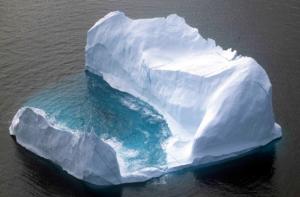How can ICESat-2 contribute to identifying and tracking icebergs in shipping lanes?

Who Cares and Why?
With a warming climate, high-latitude Arctic shipping will become increasingly possible. The year 2016 tied 2007 for the second lowest minimum ice extent in the Arctic on record at 4.4 million square kilometers. Reduction of fast ice within the calving areas promotes the release of icebergs into the Arctic Ocean. Increased shipping, fishing, energy and mineral production activities will affect national welfare and security for many nations in both the western and eastern hemisphere. This increased access to the Arctic means more and more ships and infrastructure are using the Arctic as a trade route. Indeed, Russia is investing billions of dollars in Arctic infrastructure to realize a "Suez of the north," which will further accelerate the need for accurate information about icebergs in the region.
Needed Measurements
Beyond aerial reconnaissance, remote detection of icebergs is based on active microwave, multi-polarized synthetic aperture radar (SAR) from various space-borne sensors. SAR sees the Earth's surface as a return signal (backscatter) that is proportional to the surface roughness. Differences in roughness and internal structure of the surface layer allow the different surface types to be identified. Icebergs in the Arctic are typically very rugged and rise above the level of the ocean and surrounding ice. Detecting and identifying icebergs within surrounding sea ice is particularly challenging for automated SAR algorithms. In order to produce an accurate forecast of where the icebergs will travel, changes in the mass and shape of each iceberg need to be forecasted as it is affected by ocean currents, waves, wind, and seawater of varying temperatures. Laser altimetry provides an additional avenue to validate and tune results from automated detection algorithms currently in use at IIP and CIS. A laser altimeter offers a distinct advantage over SAR in determining an iceberg’s height to allow modelers to infer important information about the iceberg’s underwater size – a key parameter in predicting both drift and deterioration. The World Meteorological Organization “Global Cryosphere Watch” program and its developing system of CryoNet stations is one of the internationally accepted mechanisms to provide comprehensive, in-situ information on icebergs to validate SAR data.
The NASA Response
Launching no later than fall of 2018, the ICESat-2 mission will use a 6-beam lidar to measure surface elevation across the globe. The micro-pulse, multi-beam Advanced Topographic Laser Altimeter System (ATLAS) will enable global, seasonal and highresolution observations and understanding of high latitude ice concentrations and behavior. The small footprints of ATLAS (~15m) combined with dense along-track spacing (~70 cm), precision elevation measurements (< 10cm over most surfaces) and geolocation knowledge (data located on earth’s surface to < 6.5m) will allow ICESat-2 data to be used as a primary data source for iceberg locations where in situ observations are lacking. ICESat-2 data will be most useful when crossing icebergs that are at least 15m across, as they will provide several consecutive elevation measurements to define the iceberg height and edges with sufficient precision.
Comments? Thoughts?
The ICESat-2 Applications website (https://icesat-2.gsfc.nasa.gov/applications) provides information on the Early Adopter program. Readers can attend applications events (e.g. workshops, focus sessions and tutorials) or join our community listserv (https://lists.nasa.gov/mailman/listinfo/icesat-2-applications/) to stay informed about future activities. For additional information about ICESat-2 mission applications or this particular application, please contact ICESat-2 Applications Team at: icesat-2-applications@lists.nasa.gov.


